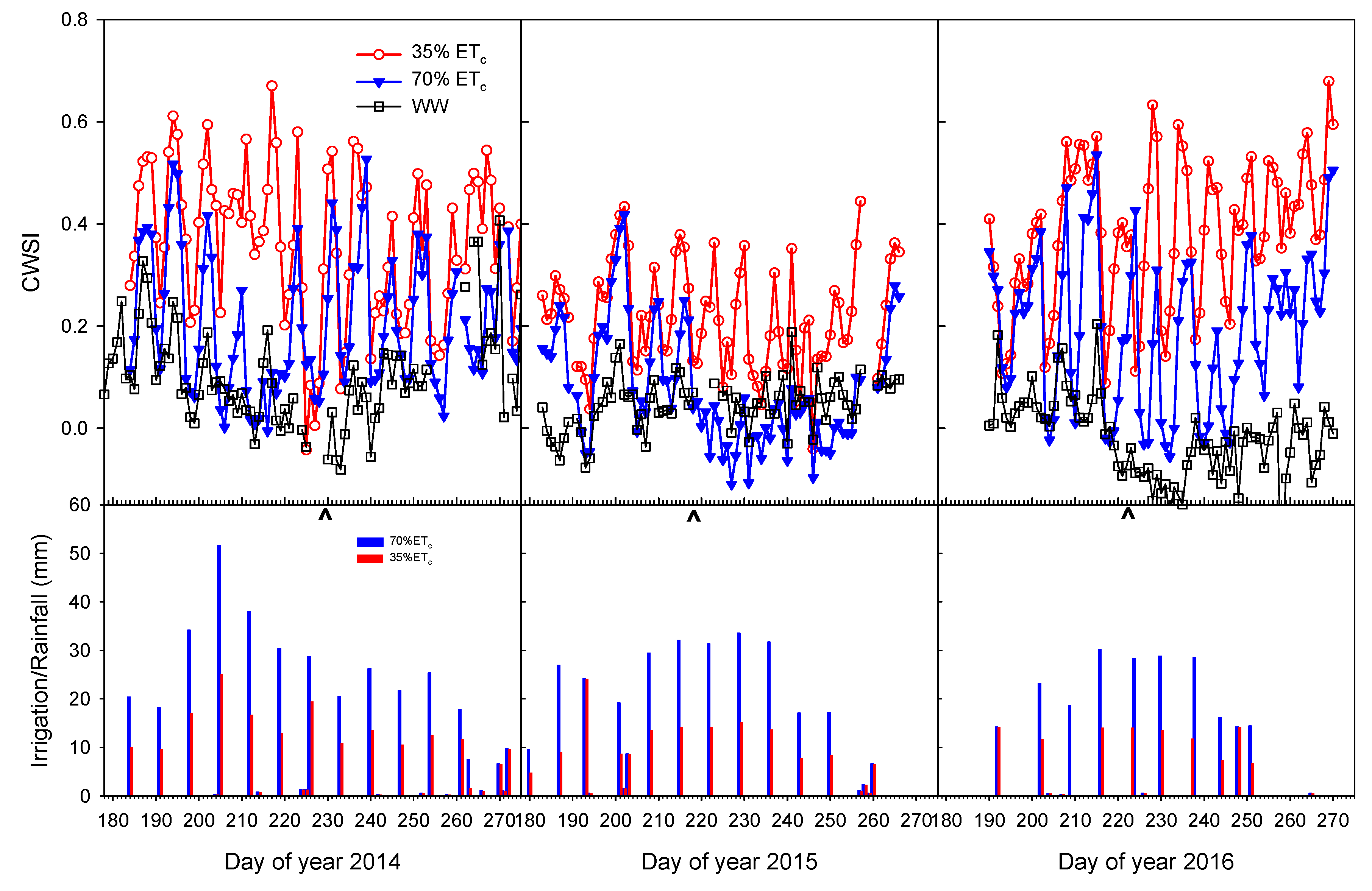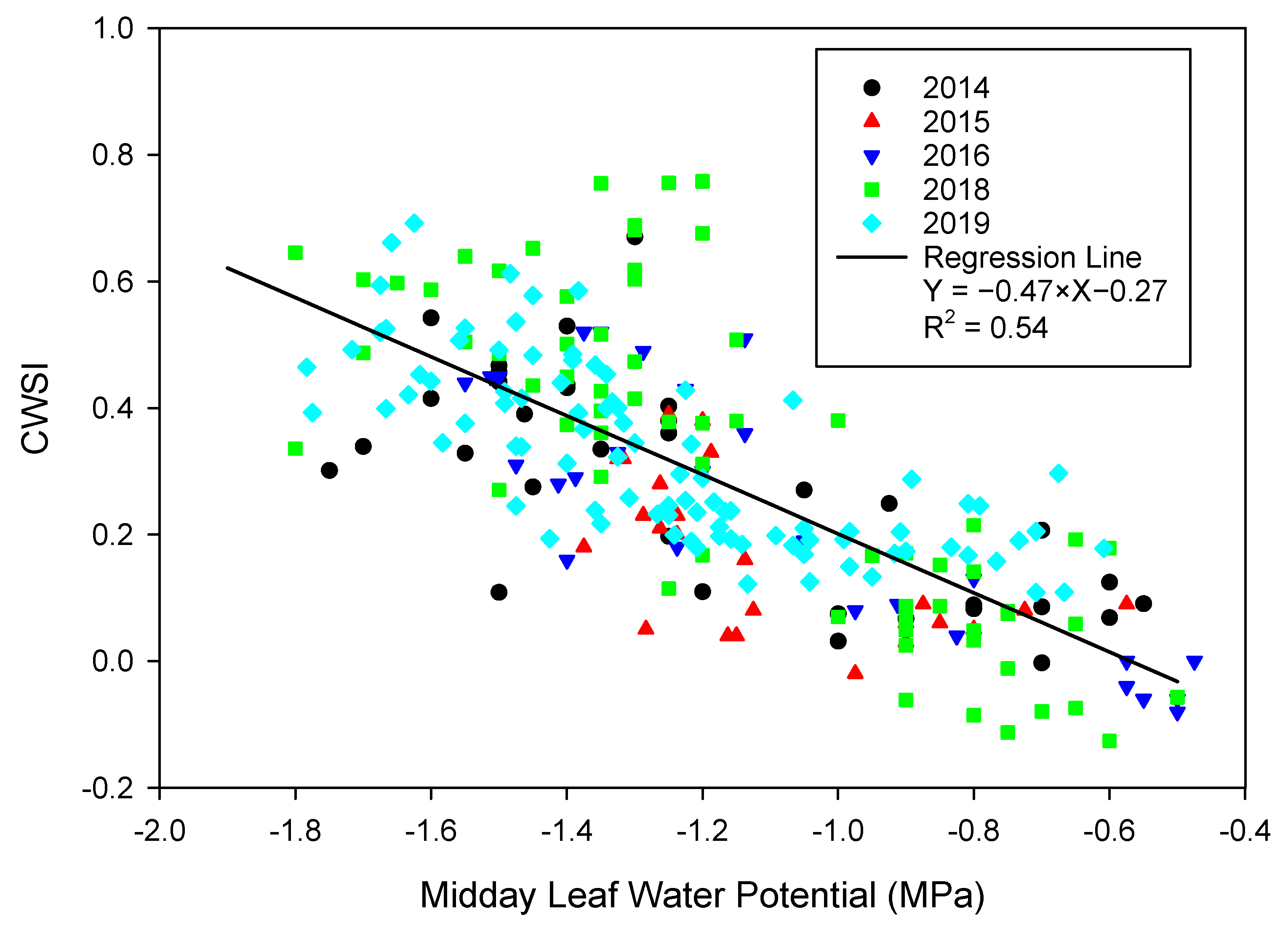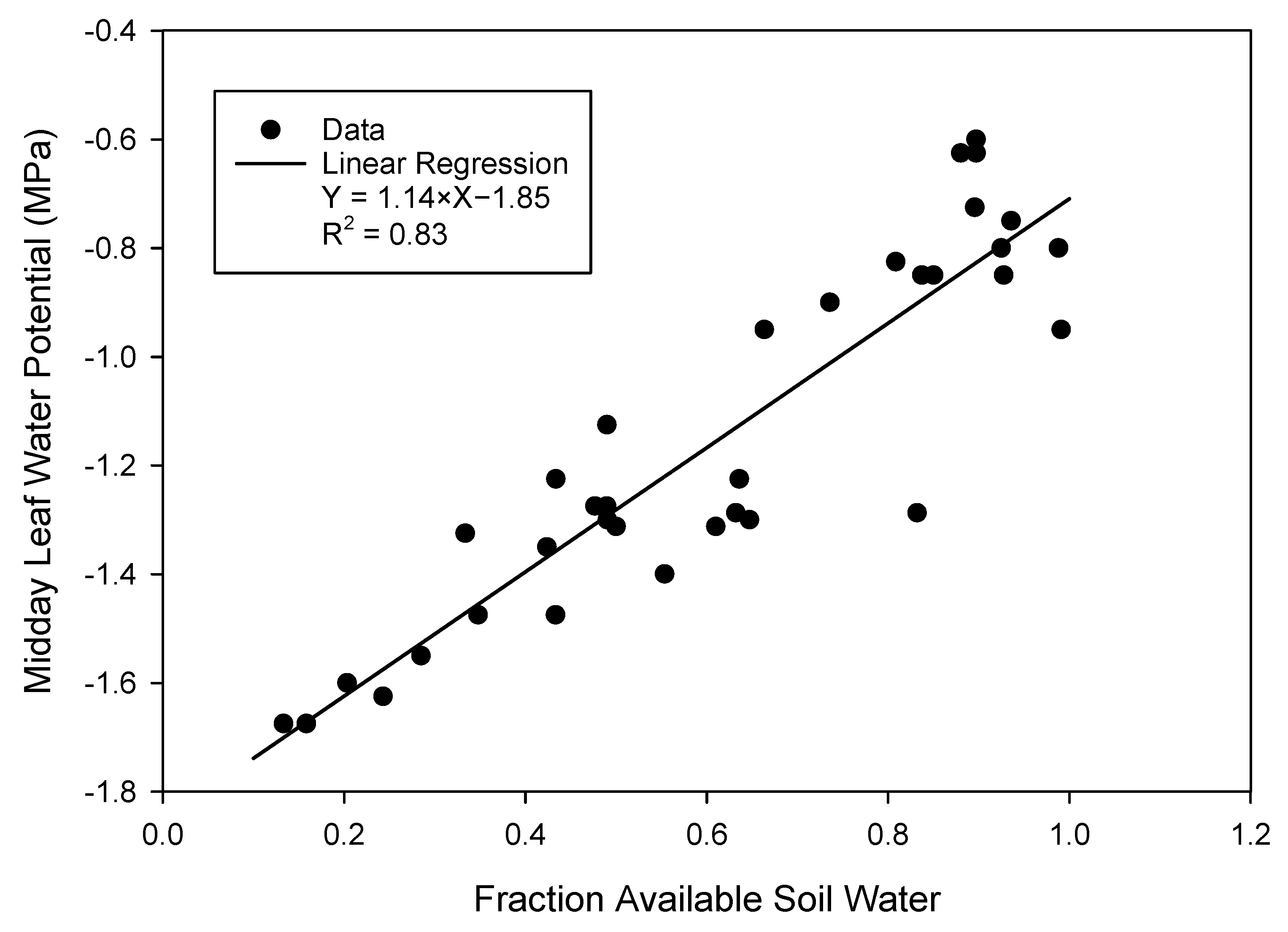Application of a Daily Crop Water Stress Index to Deficit Irrigate Malbec Grapevine under Semi-Arid Conditions
Abstract
1. Introduction
2. Materials and Methods
2.1. Trial Site and Experimental Design
2.2. Canopy and Environmental Measurements
2.3. CWSI Calculation
2.4. Soil Water Measurement
2.5. Vine Water Status
2.6. Yield Components and Berry Composition
2.7. Statistical Analysis
3. Results
3.1. Environmental Conditions and Irrigation Amounts
3.2. Indicators of Water Stress
3.3. Relationship among Water Stress Indicators
3.4. Yield Components and Berry Composition
4. Discussion
5. Conclusions
Author Contributions
Funding
Acknowledgments
Conflicts of Interest
References
- Chaves, M.M.; Francisco, Z.R.; Costa, J.M.; Santos, T.; Regalado, A.P.; Rodrigues, M.L.; Lopes, C.M. Grapevine under deficit irrigation: Hints from physiological and molecular data. Ann. Bot. London 2010, 105, 661–676. [Google Scholar] [CrossRef] [PubMed]
- Sadras, V.O.; Moran, M.A. Elevated temperature decouples anthocyanins and sugars in berries of Shiraz and Cabernet Franc. Aust. J. Grape Wine Res. 2012, 18, 115–122. [Google Scholar] [CrossRef]
- Chaves, M.M.; Santos, T.P.; Souza, C.R.; Ortuno, M.F.; Rodrigues, M.L.; Lopes, C.M. Deficit irrigation in grapevine improves water-use efficiency while controlling vigour and production quality. Ann. Appl. Biol. 2007, 150, 237–252. [Google Scholar] [CrossRef]
- Fereres, E.; Soriano, M.A. Deficit irrigation for reducing agricultural water use. J. Exp. Bot. 2007, 58, 147–159. [Google Scholar] [CrossRef] [PubMed]
- Shellie, K.C. Water productivity, yield, and berry composition in sustained versus regulated deficit irrigation of Merlot grapevines. Am. J. Enol. Vitic. 2014, 65, 197–205. [Google Scholar] [CrossRef]
- Allen, R.G.; Pereira, L.S.; Raes, D.; Smith, M. Crop Evapotranspiration-Guidelines for Computing Crop Water Requirements-FAO Irrigation and Drainage Paper 56, 1st ed.; Food and Agricultural Organizationof the United Nations: Rome, Italy, 1998; pp. 51–131. ISBN 92-5-104219-5. [Google Scholar]
- Cohen, Y.; Alchanatis, V.; Meron, M.; Saranga, Y.; Tsipris, J. Estimation of leaf water potential by thermal imagery and spatial analysis. J. Exp. Bot. 2005, 56, 1843–1852. [Google Scholar] [CrossRef] [PubMed]
- Glenn, M.D.; Cooley, N.; Walker, R.; Clingeleffer, P.; Shellie, K. Impact of kaolin particle film and water deficit on wine grape water use efficiency and plant water relations. HortScience 2010, 45, 1178–1187. [Google Scholar] [CrossRef]
- Shellie, K.C.; King, B.A. Kaolin particle film and water deficit influence Malbec leaf and berry temperature, pigments, and photosynthesis. Am. J. Enol. Vitic. 2013, 64, 223–230. [Google Scholar] [CrossRef]
- Bellvert, J.; Zarco-Tejada, P.J.; Girona, J.; Fereres, E. Mapping crop water stress index in a ‘Pinot-noir’ vineyard: Comparing ground measurements with thermal remote sensing imagery from an unmanned aerial vehicle. Precis. Agric. 2014, 15, 361–376. [Google Scholar] [CrossRef]
- Bellvert, J.; Marsal, J.; Girona, J.; Zarco-Tejada, P.J. Seasonal evolution of crop water stress index in grapevine varieties determined with high-resolution remote sensing thermal imagery. Irrig. Sci. 2015, 33, 81–93. [Google Scholar] [CrossRef]
- Idso, S.B.; Jackson, R.D.; Pinter, P.J.; Reginato, R.J.; Hatfield, J.L. Normalizing the stress-degree-day parameter for environmental variability. Agr. Meteorol. 1981, 24, 45–55. [Google Scholar] [CrossRef]
- Jackson, R.D.; Idso, S.B.; Reginato, R.J.; Pinter, P.J. Canopy temperature as a drought stress indicator. Water Resour. Res. 1981, 13, 651–656. [Google Scholar] [CrossRef]
- Jones, H.G. Plants and Microclimate, 2nd ed.; Cambridge University Press: Cambridge, UK, 1992; pp. 231–239. ISBN 978-0521425247. [Google Scholar]
- Alchanatis, V.; Cohen, Y.; Cohen, S.; Möller, M.; Sprinstin, M.; Meron, M.; Tsipris, J.; Saranga, Y.; Sela, E. Evaluation of different approaches for estimating and mapping crop water status in cotton using thermal imaging. Precision Ag. 2010, 11, 27–41. [Google Scholar] [CrossRef]
- Jones, H.G. Use of infrared thermometry for estimation of stomatal conductance as a possible aid to irrigation scheduling. Agric. For. Meteorol. 1999, 95, 139–149. [Google Scholar] [CrossRef]
- Jones, H.G.; Stoll, M.; Santos, T.; de Sousa, C.; Chaves, M.M.; Grant, O.M. Use of infrared thermography for monitoring stomatal closure in the field: Application to grapevine. J. Exp. Bot. 2002, 53, 2249–2260. [Google Scholar] [CrossRef]
- Leinonen, I.; Jones, H.G. Combining thermal and visible imagery for estimating canopy temperature and identifying plant stress. J. Exper. Botany 2004, 55, 1423–1431. [Google Scholar] [CrossRef]
- O’Shaughnessy, S.A.; Evett, S.R.; Colaizzi, P.D.; Howell, T.A. Using radiation thermography and thermometry to evaluate crop water stress in soybean and cotton. Ag. Water Manag. 2011, 98, 1523–1535. [Google Scholar] [CrossRef]
- Pou, A.; Diago, M.P.; Medrano, H.; Baluja, J.; Tardaguila, J. Validation of thermal indices for water status identification in grapevine. Ag. Water Manag. 2014, 134, 60–72. [Google Scholar] [CrossRef]
- Payero, J.O.; Irmak, S. Variable upper and lower crop water stress index baselines for corn and soybean. Irrig. Sci. 2006, 25, 21–32. [Google Scholar] [CrossRef]
- King, B.A.; Shellie, K.C. Evaluation of neural network modeling to predict non-water-stressed leaf temperature in wine grape for calculation of crop water stress index. Ag. Water Manag. 2016, 167, 38–52. [Google Scholar] [CrossRef]
- Belfiore, N.; Vinti, R.; Lovat, L.; Chitarra, W.; Tomasi, D.; de Bei, R.; Meggio, F.; Gaiotti, F. Infrared thermography to estimate vine water status: Optimizing canopy measurements and thermal indices for the varieties Merlot and Moscato in northern Italy. Agronomy 2019, 9, 821. [Google Scholar] [CrossRef]
- Fuentes, S.; de Bei, R.; Pech, J.; Tyerman, S. Computational water stress indices obtained from thermal image analysis of grapevine canopies. Irrig. Sci. 2012, 30, 523–536. [Google Scholar] [CrossRef]
- Irmak, S.; Haman, D.Z.; Bastug, R. Determination of crop water stress index for irrigation timing and yield estimation of corn. Agron. J. 2000, 92, 1221–1227. [Google Scholar] [CrossRef]
- Möller, M.; Alchanatis, V.; Cohen, Y.; Meron, M.; Tsipris, J.; Naor, A.; Ostrovsky, V.; Sprintsin, M.; Cohen, S. Use of thermal and visible imagery for estimating crop water status of irrigated grapevine. J. Exp. Botany 2007, 58, 827–838. [Google Scholar] [CrossRef] [PubMed]
- O’Toole, J.C.; Real, J.G. Estimation of aerodynamic and crop resistances from canopy temperature. Agron. J. 1986, 78, 305–310. [Google Scholar] [CrossRef]
- Han, M.; Zhang, H.; Chavez, J.L.; Ma, L.; Trout, T.J.; DeJonge, K.C. Improved soil water deficit estimation through integration of canopy temperature measurement into a soil water balance model. Irrig. Sci. 2018, 36, 187–201. [Google Scholar] [CrossRef]
- Keller, M.; Smithyman, R.P.; Mills, L.J. Interactive effects of deficit irrigation and crop load on Cabernet Sauvignon in an arid climate. Am. J. Enol. Vitic. 2008, 59, 221–234. [Google Scholar]
- Coombe, B.G. Growth stages of the grapevine: Adoption of a system for identifying grapevine growth stages. Aust. J. Grape Wine Res. 1995, 1, 104–110. [Google Scholar] [CrossRef]
- King, B.A.; Shellie, K.C. Wine grape cultivar influence on the performance of models that predict the lower threshold canopy temperature of a water stress index. Comput. Electron. Ag. 2018, 145, 122–129. [Google Scholar] [CrossRef]
- Herrero-Langreo, A.; Tisseyre, B.; Goutouly, J.; Scholasch, T.; Van Leeuwen, C. Mapping grapevine (Vitis vinifera L.) water status during the season using carbon isotope ratio (δ13C) as ancillary data. Am. J. Enol. Vitic. 2013, 64, 307–315. [Google Scholar] [CrossRef]
- Iland, P.; Bruer, N.; Edwards, G.; Weeks, S.; Wilkes, E. Chemical Analysis of Grapes and Wine: Techniques and Concepts, 1st ed.; Patrick Iland Wine Promotions PTY LTD: Athelstone, Australia, 2004; pp. 1–120. ISBN 978-0958160513. [Google Scholar]
- Shellie, K.C. Vine and berry response of Merlot (Vitis vinifera L.) to differential water stress. Am. J. Enol. Vitic. 2006, 57, 514–518. [Google Scholar]
- Grant, O.M.; Tronina, L.; Jones, H.G.; Chaves, M.M. Exploring thermal imaging variable for the detection of stress responses in grapevine under different irrigation regimes. J. Exp. Bot. 2007, 58, 815–825. [Google Scholar] [CrossRef] [PubMed]
- Levin, A.D. Re-evaluating pressure chamber methods of water stress determination in field-grown grapevine. Ag. Water Manag. 2019, 221, 422–429. [Google Scholar] [CrossRef]
- Williams, L.W.; Baeza, P. Relationships among ambient temperature and vapor pressure deficit and leaf and stem water potentials of fully irrigated, field grown grapevines. Am. J. Enol. Vitic. 2007, 58, 173–181. [Google Scholar]
- Williams, L.E.; Trout, T.J. Relationships among vine and soil based measures of water status in a ‘Thompson Seedless’ vineyard in response to high frequency drip irrigation. Am. J. Enol. Vitic. 2005, 56, 357–366. [Google Scholar]
- Gaudillère, J.P.; Van Leeuwen, C.; Ollat, N. Carbon isotope composition of sugars in grapevine, an integrated indicator of vineyard water status. J. Exp. Bot. 2002, 53, 757–763. [Google Scholar] [CrossRef]







| Parameters | 2014 | 2015 | 2016 | 2018 | 2019 | 1994–2012 Average ± Std Dev |
|---|---|---|---|---|---|---|
| Precipitation (mm) | 88 | 113 | 120 | 66 | 175 | 99.6 ± 35 |
| Solar radiation (MJ m−2 d−1) | 22.3 | 21.9 | 22.6 | 22.5 | 22.0 | 22.1 ± 0.9 |
| Days air temperature > 35 °C | 27 | 25 | 26 | 33 | 27 | 28 ± 12 |
| Growing degree days (°C) a | 1759 | 1865 | 1688 | 1762 | 1608 | 1708 ± 115 |
| Alfalfa-based reference evapotranspiration (ETr) (mm) | 1314 | 1265 | 1329 | 1334 | 1243 | 1212 ± 55 |
| Treatment b | Irrigation amount (mm) | |||||
| Well-Watered | 521 | 514 | 669 | |||
| 100% ETc | 304 | |||||
| 70% ETc | 306 | 284 | 174 | |||
| 50% ETc | 107 | |||||
| 35% ETc | 190 | 123 | 117 | |||
| CWSI = 0.3 | 233 | |||||
| CWSI = 0.4 | 172 | |||||
| CWSI = 0.5 | 148 | |||||
| CWSI = 0.6 | 68 | |||||
| Main Effect a | Weekly CWSI (0–1) | Ψlmd (MPa) | Juice δ13C | Berry Weight (g) |
|---|---|---|---|---|
| % ETc: 35 | 0.31a | −1.29a | −24.09a | 1.35a |
| 70 | 0.09b | −1.20b | −25.78b | 1.51b |
| Year: 2014 | 0.29a | −1.29a | −25.22b | 1.42b |
| 2015 | 0.14b | −1.20b | −25.08b | 1.34b |
| 2016 | 0.17b | −1.23ab | −24.50a | 1.52a |
| p values | ||||
| Irrigation (I) | ** | * | ** | ** |
| Year | ** | * | ** | ** |
| I × Year | ** | ns | ns | ns |
| Year: 2018 | ||||
| % ETc: 50 | 0.42a | −1.29a | −24.61a | 1.44a |
| 100 | 0.08b | −0.80b | −26.98b | 1.82b |
| p values | ||||
| Irrigation | ** | ** | ** | ** |
| Year: 2019 | ||||
| CWSIb: 0.3 | 0.24a | −1.00a | −26.32a | 1.79a |
| 0.4 | 0.27a | −1.18b | −25.56b | 1.79a |
| 0.5 | 0.34b | −1.31c | −25.20b | 1.48b |
| 0.6 | 0.43c | −1.48d | −24.18c | 1.30c |
| p values | ||||
| CWSI | ** | ** | ** | ** |
| Main Effect a | Cluster Weight (g) | Yield (kg) | Cluster Number per Vine | Ravaz Index |
|---|---|---|---|---|
| % ETc 35 | 104.97a | 4.06a | 39.47a | 4.05 |
| 70 | 150.51b | 6.90b | 53.54b | 4.95 |
| Year: 2014 | 157.01a | 5.81a | 48.92b | 4.35 |
| 2015 | 103.42b | 4.00b | 21.72a | 4.59 |
| 2016 | 122.79b | 6.63a | 68.88a | 4.56 |
| p-values | ||||
| Irrigation (I) | ** | ** | ** | ns |
| Year | ** | ** | ** | ns |
| I × Year | ns | ns | ** | ns |
| Year: 2018 | ||||
| % ETc 50 | 193.42a | 6.00a | 32.03a | 5.19a |
| 100 | 235.69b | 7.47a | 28.93b | 3.94b |
| p-values | ||||
| Irrigation | ** | ns | * | * |
| Year: 2019 | ||||
| CWSI b 0.3 | 197.71a | 8.39 | 49.0 | 5.72 |
| 0.4 | 176.76ab | 7.28 | 46.8 | 5.16 |
| 0.5 | 145.02b | 7.09 | 51.6 | 6.22 |
| 0.6 | 147.39b | 7.19 | 50.9 | 5.43 |
| p-values | ||||
| CWSI | * | ns | ns | ns |
| Main Effect a | Titratable Acidity (g/mL) | Soluble Solids (%) | Anthocyanins (mg/g) | Anthocyanins (mg/berry) |
|---|---|---|---|---|
| % ETc 35 | 4.490a | 23.7a | 2.071a | 2.799a |
| 70 | 5.052b | 23.0b | 1.827b | 2.756a |
| Year: 2014 | 5.289 | 23.1ab | 1.997ab | 2.839b |
| 2015 | 4.768 | 23.0b | 1.776b | 2.358c |
| 2016 | 4.256 | 24.0a | 2.034a | 3.136a |
| p-values | ||||
| Irrigation (I) | ** | * | * | ns |
| Year | ** | * | * | ** |
| I × Year | * | ns | ns | ns |
| Year: 2018 | ||||
| % ETc 50 | 4.174a | 24.5a | 1.839a | 2.639a |
| 100 | 5.085b | 23.5b | 1.408b | 2.566b |
| p-values | ||||
| Irrigation | ** | ** | ** | ns |
| Year: 2019 | ||||
| CWSI b 0.3 | 4.793a | 22.8 | 1.532a | 2.760a |
| 0.4 | 4.475a | 22.9 | 1.577a | 2.831a |
| 0.5 | 3.679b | 22.5 | 1.453b | 2.148b |
| 0.6 | 3.628b | 22.4 | 1.745a | 2.265b |
| p-values | ||||
| CWSI | ** | ns | * | * |
Publisher’s Note: MDPI stays neutral with regard to jurisdictional claims in published maps and institutional affiliations. |
© 2020 by the authors. Licensee MDPI, Basel, Switzerland. This article is an open access article distributed under the terms and conditions of the Creative Commons Attribution (CC BY) license (http://creativecommons.org/licenses/by/4.0/).
Share and Cite
Shellie, K.C.; King, B.A. Application of a Daily Crop Water Stress Index to Deficit Irrigate Malbec Grapevine under Semi-Arid Conditions. Agriculture 2020, 10, 492. https://doi.org/10.3390/agriculture10110492
Shellie KC, King BA. Application of a Daily Crop Water Stress Index to Deficit Irrigate Malbec Grapevine under Semi-Arid Conditions. Agriculture. 2020; 10(11):492. https://doi.org/10.3390/agriculture10110492
Chicago/Turabian StyleShellie, Krista C., and Bradley A. King. 2020. "Application of a Daily Crop Water Stress Index to Deficit Irrigate Malbec Grapevine under Semi-Arid Conditions" Agriculture 10, no. 11: 492. https://doi.org/10.3390/agriculture10110492
APA StyleShellie, K. C., & King, B. A. (2020). Application of a Daily Crop Water Stress Index to Deficit Irrigate Malbec Grapevine under Semi-Arid Conditions. Agriculture, 10(11), 492. https://doi.org/10.3390/agriculture10110492





